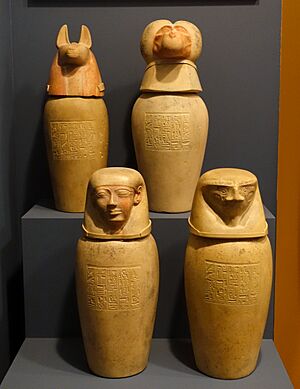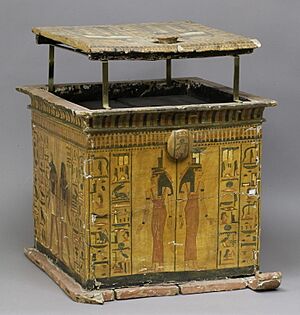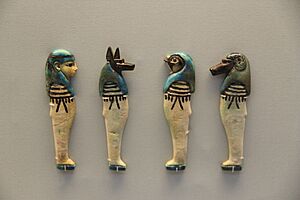Canopic jar facts for kids
Canopic jars were special containers used by the ancient Egyptians. They were a very important part of the mummification process. Egyptians used these jars to store and protect the internal organs of a person who had died. They believed this helped the person's body stay safe for the afterlife.
The first canopic jars were often made from stone. Later, some were carved from wood. Egyptians used these jars for a very long time, starting in the Old Kingdom and continuing until the Ptolemaic Period. Over time, the way organs were handled changed. Sometimes, they were just wrapped and placed with the body.
Early canopic jars from the Old Kingdom usually had plain lids and no writing. But by the Middle Kingdom, jars often had words written on them. Their lids also started to look like human heads. Later, around the Nineteenth Dynasty, each of the four jar lids showed one of the Four sons of Horus. These gods were thought to protect the organs inside.
Contents
What's in a Name?
The word canopic comes from a mistake made by early experts who studied Egypt. They thought these jars were linked to an old Greek story about a captain named Canopus. He was said to be buried in a place called Canopus in Egypt. People there worshipped jars that looked like human heads. So, the name "canopic" stuck!
How Were They Designed?
Canopic jars were shaped like vases, hollow inside, and had special lids. They were usually between 14 cm and 50 cm tall, including the lid. Their width could be from 6 cm to 20 cm.
The most common materials for making these jars were wood, limestone, and clay. Sometimes, they were made from a shiny material called faience. The jars often had painted faces, the name of the person who died, or even special burial spells.
At first, canopic jars were placed inside a canopic chest. This chest was then buried in the tomb with the dead person's sarcophagus. Later, the jars were sometimes placed in rows or at the four corners of the burial room.
In the Old Kingdom, the jars had simple, round stoppers. Lids shaped like human heads first appeared in the First Intermediate Period. These human heads represented the Sons of Horus in their human form. This style was popular until the New Kingdom, especially in the Nineteenth Dynasty. Then, the lids changed to show the more famous animal heads of the gods. Many fancy sets from this time were made from beautiful stones like alabaster or blue and green glazed porcelain.
Why Were They Used?
Egyptians started removing organs during mummification very early, in the Old Kingdom. But using jars to store these organs became common later, during the First Intermediate Period.
When a body was mummified, the lungs, liver, stomach, and intestines were carefully taken out. This was done to stop them from decaying the rest of the body. Each organ was dried with a special salt called natron. Then, it was placed into one of the four canopic jars. The heart was never removed. Egyptians believed the heart was where the soul lived, so it stayed inside the body.
Some very old canopic jars from the Old Kingdom have been found empty and damaged. This suggests they were part of the burial ceremony, but not always used to hold organs. Later, during the Third Intermediate Period, Egyptians sometimes placed much smaller "dummy" jars in tombs. These jars were not hollow and did not contain organs. This happened because embalming methods improved, allowing the organs to stay inside the body. Even so, the traditional jars remained a part of tombs.
Gods and Organs
Each of the Four Sons of Horus was in charge of protecting a specific organ. Each god also had a special goddess who protected him, and each represented a direction:
- Hapi: This god had the head of a baboon. He represented the North and was protected by the goddess Nephthys. Hapi was responsible for the lungs.
- Duamutef: This god had the head of a jackal. He represented the East and was protected by the goddess Neith. Duamutef was responsible for the stomach.
- Imseti: This god had a human head. He represented the South and was protected by the goddess Isis. Imseti was responsible for the liver.
- Qebehsenuef: This god had the head of a falcon. He represented the West and was protected by the goddess Serket. Qebehsenuef was responsible for the intestines.
A Special Discovery
In 2020, archaeologists found something interesting at Saqqara. They discovered the 2,600-year-old tomb of a woman named Didibastet. Her tomb was untouched behind a stone wall. What was unusual was that she was buried with six canopic jars, not the usual four! A CT scan showed that these jars contained human tissue. This suggests that Didibastet's mummification might have been done in a very specific way, perhaps at her special request.
Gallery
-
Canopic jars of Tutankhamun; made of alabaster.
See also
 In Spanish: Vaso canopo para niños
In Spanish: Vaso canopo para niños







